Expression of U1 small nuclear ribonucleoprotein 70K antisense transcript using APETALA3 promoter suppresses the development of sepals and petals
- PMID: 12913145
- PMCID: PMC181274
- DOI: 10.1104/pp.103.023192
Expression of U1 small nuclear ribonucleoprotein 70K antisense transcript using APETALA3 promoter suppresses the development of sepals and petals
Abstract
U1 small nuclear ribonucleoprotein (snRNP)-70K (U1-70K), a U1 snRNP-specific protein, is involved in the early stages of spliceosome formation. In non-plant systems, it is involved in constitutive and alternative splicing. It has been shown that U1snRNP is dispensable for in vitro splicing of some animal pre-mRNAs, and inactivation of U1-70K in yeast (Saccharomyces cerevisiae) is not lethal. As in yeast and humans (Homo sapiens), plant U1-70K is coded by a single gene. In this study, we blocked the expression of Arabidopsis U1-70K in petals and stamens by expressing U1-70K antisense transcript using the AP3 (APETALA3) promoter specific to these floral organs. Flowers of transgenic Arabidopsis plants expressing U1-70K antisense transcript showed partially developed stamens and petals that are arrested at different stages of development. In some transgenic lines, flowers have rudimentary petals and stamens and are male sterile. The severity of the phenotype is correlated with the level of the antisense transcript. Molecular analysis of transgenic plants has confirmed that the observed phenotype is not due to disruption of whorl-specific homeotic genes, AP3 or PISTILLATA, responsible for petal and stamen development. The AP3 transcript was not detected in transgenic flowers with severe phenotype. Flowers of Arabidopsis plants transformed with a reporter gene driven by the same promoter showed no abnormalities. These results show that U1-70K is necessary for the development of sepals and petals and is an essential gene in plants.
Figures
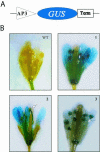
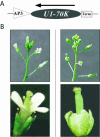
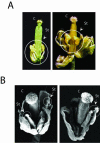
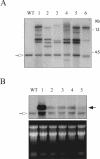
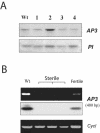
Similar articles
-
Structure and expression of a plant U1 snRNP 70K gene: alternative splicing of U1 snRNP 70K pre-mRNAs produces two different transcripts.Plant Cell. 1996 Aug;8(8):1421-35. doi: 10.1105/tpc.8.8.1421. Plant Cell. 1996. PMID: 8776903 Free PMC article.
-
pistillata-5, an Arabidopsis B class mutant with strong defects in petal but not in stamen development.Plant J. 2003 Jan;33(1):177-88. doi: 10.1046/j.1365-313x.2003.01603.x. Plant J. 2003. PMID: 12943551
-
Exogenous Promoter Triggers APETALA3 Silencing through RNA-Directed DNA Methylation Pathway in Arabidopsis.Int J Mol Sci. 2019 Sep 11;20(18):4478. doi: 10.3390/ijms20184478. Int J Mol Sci. 2019. PMID: 31514282 Free PMC article.
-
The plant U1 small nuclear ribonucleoprotein particle 70K protein interacts with two novel serine/arginine-rich proteins.Plant Cell. 1998 Oct;10(10):1637-48. doi: 10.1105/tpc.10.10.1637. Plant Cell. 1998. PMID: 9761791 Free PMC article.
-
Direct regulation of the floral homeotic APETALA1 gene by APETALA3 and PISTILLATA in Arabidopsis.Plant J. 2006 May;46(4):593-600. doi: 10.1111/j.1365-313X.2006.02720.x. Plant J. 2006. PMID: 16640596
Cited by
-
Analyses of the floral organ morphogenesis and the differentially expressed genes of an apetalous flower mutant in Brassica napus.Plant Cell Rep. 2008 Jan;27(1):9-20. doi: 10.1007/s00299-007-0426-4. Epub 2007 Sep 20. Plant Cell Rep. 2008. PMID: 17882424
-
The ASRG database: identification and survey of Arabidopsis thaliana genes involved in pre-mRNA splicing.Genome Biol. 2004;5(12):R102. doi: 10.1186/gb-2004-5-12-r102. Epub 2004 Nov 29. Genome Biol. 2004. PMID: 15575968 Free PMC article.
-
The U1 snRNP Subunit LUC7 Modulates Plant Development and Stress Responses via Regulation of Alternative Splicing.Plant Cell. 2018 Nov;30(11):2838-2854. doi: 10.1105/tpc.18.00244. Epub 2018 Oct 11. Plant Cell. 2018. PMID: 30309899 Free PMC article.
-
pur4 mutations are lethal to the male, but not the female, gametophyte and affect sporophyte development in Arabidopsis.Plant Physiol. 2008 Jun;147(2):650-60. doi: 10.1104/pp.108.120014. Epub 2008 Apr 25. Plant Physiol. 2008. PMID: 18441219 Free PMC article.
-
Construction of efficient and effective transformation vectors for palmitoyl-acyl carrier protein thioesterase gene silencing in oil palm.Bioinformation. 2011;6(6):212-20. doi: 10.6026/97320630006212. Epub 2011 Jun 6. Bioinformation. 2011. PMID: 21738318 Free PMC article.
References
-
- Arabidopsis Genome Initiative (2000) Analysis of the genome sequence of the flowering plant Arabidopsis thaliana. Nature 408: 796–815 - PubMed
-
- Bechtold N, Ellis J, Pelletier G (1993) In planta Agrobacterium mediated gene transfer by infiltration of adult Arabidopsis thaliana plants. C R Acad Sci 316: 1194–1199 - PubMed
-
- Bowman JL, Smyth DR, Meyerowitz EM (1991) Genetic interactions among floral homeotic genes of Arabidopsis. Development 112: 1–20 - PubMed
-
- Brett D, Hanke J, Lehmann G, Haase S, Delbruck S, Krueger S, Reich J, Borka P (2000) EST comparison indicates 38% of human mRNAs contain possible alternative splice forms. FEBS Lett 474: 83–86 - PubMed
Publication types
MeSH terms
Substances
LinkOut - more resources
Full Text Sources
Molecular Biology Databases
Research Materials

